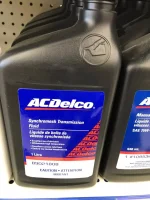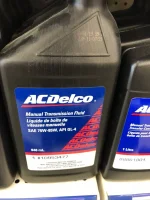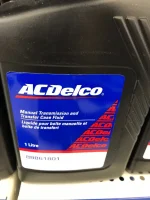You are using an out of date browser. It may not display this or other websites correctly.
You should upgrade or use an alternative browser.
You should upgrade or use an alternative browser.
AC Delco Manual Transmission Fluids
- Thread starter Snagglefoot
- Start date
- Status
- Not open for further replies.
Photo 1:
Synchromesh Transmission Fluid
Canada:89021808
USA:88900333, formerly 12345349
https://www.amazon.com/Genuine-GM-88900333-Synchromesh-Transmission/dp/B007TYSYNU
Not Pictured:
Synchromesh Transmission Fluid - Friction Modified
USA:88900399, formerly 12377916
This has a different friction modifier than that contained in the one above.
https://www.amazon.com/Genuine-GM-88900399-Synchromesh-Transmission/dp/B00BK7M2VW
Photo 2:
Manual Transmission Fluid, GL-4
Canada:10953477
USA:12346190
Typographical error on bottle says "SAE 75W-85W."
https://www.amazon.com/Genuine-GM-12346190-Synthetic-Transmission/dp/B000QIR1V2
Photo 3:
Manual Transmission and Transfer Case Fluid
Canada:88861801
USA:88861800
This is actually Dexron III, now sold with a different label.
https://www.amazon.com/Genuine-Fluid-88861800-Manual-Transmission/dp/B00BK7M1EK
Synchromesh Transmission Fluid
Canada:89021808
USA:88900333, formerly 12345349
https://www.amazon.com/Genuine-GM-88900333-Synchromesh-Transmission/dp/B007TYSYNU
Not Pictured:
Synchromesh Transmission Fluid - Friction Modified
USA:88900399, formerly 12377916
This has a different friction modifier than that contained in the one above.
https://www.amazon.com/Genuine-GM-88900399-Synchromesh-Transmission/dp/B00BK7M2VW
Photo 2:
Manual Transmission Fluid, GL-4
Canada:10953477
USA:12346190
Typographical error on bottle says "SAE 75W-85W."
https://www.amazon.com/Genuine-GM-12346190-Synthetic-Transmission/dp/B000QIR1V2
Photo 3:
Manual Transmission and Transfer Case Fluid
Canada:88861801
USA:88861800
This is actually Dexron III, now sold with a different label.
https://www.amazon.com/Genuine-Fluid-88861800-Manual-Transmission/dp/B00BK7M1EK
Perhaps not a typo, according to this; however, the USA bottle (12346190) indicates 75W-85, not 75W-85W.Typographical error on bottle says "SAE 75W-85W."
MolaKule
Staff member
Photo 3:
Manual Transmission and Transfer Case Fluid
Canada:88861801
USA:88861800
This is actually Dexron III, now sold with a different label.
No, it is a completely different formulation.
This bulletin is posted in many threads here and on other sites:No, it is a completely different formulation.This is actually Dexron III, now sold with a different label.
This information applies to 2007 and prior GM passenger cars and trucks. Dexron III is being phased out as a product name. It is being renamed Manual Transmission and Transfer Case Fluid and carries p/n 88861800 US (88861801 Canada). If fluid p/n 88861800 US (88861801 Canada) is not yet available when servicing a manual transmission or transfer case, Dexron III can be used in its place. DO NOT used Dexron VI in place of manual transmission fluid in any manual transmissions or transfer cases that specify Dexron III, as a failure may result.
Uh oh...mixing is taboo topic here.Synchromesh...Great as part of a gear oil cocktail...
MolaKule
Staff member
This bulletin is posted in many threads here and on other sites:
I analyzed the fluid about two months ago and it is not the same formulation as Dexron III-H.
Last edited:
Interesting. I'm surprised that 88861800 is a "completely different formulation" than Dexron III-H. It's commonly believed that they're the same.I analyzed the fluid about two months ago and it is not the same formulation as Dexron III-H.
For example, the Conklin Company Inc. lists it this way: DEXRON®-III H (Manual Transmission Fluid #88861800), and 88861800 is not listed next to prior versions of Dexron III in that document.
Yes, but it's generally believed that the GM p/n 88861800 fluid is just Dexron III-H.
https://www.ls1gto.com/threads/dexron-iii-vs-dexron-vi.283117/page-2 said:I work at a dealership, the new # is 88861800.
MolaKule
Staff member
Well, the Conklin Company needs to be corrected. I don't think a chemist wrote that.
P/N 12346190 and the Chrysler equivalent are made from unicorn tears. When I checked a few years back, it was the only fluid approved for the NV4500 manual transmissions in the heavy duty pickups, and at the time, was only available from dealers. Looks like that's not the case now, but at $32 a quart it still must be made from those tears.
Perhaps, but GM apparently believed they were the same when they issued the aforementioned bulletin, long after the advent of Dexron-III(H). Which additives/amounts are different? Would you mind posting your analyses of the two fluids?Well, the Conklin Company needs to be corrected. I don't think a chemist wrote that.
Some manual transmission fluids seem to be rather expensive (>$20/quart). Why? Profiteering? Not sure what makes 12346190 special, as there exist other GL-4 fluids of similar viscosity. Any ideas? The 75W-85W label seems abusive of the labeling standard.P/N 12346190 and the Chrysler equivalent are made from unicorn tears. When I checked a few years back, it was the only fluid approved for the NV4500 manual transmissions in the heavy duty pickups, and at the time, was only available from dealers. Looks like that's not the case now, but at $32 a quart it still must be made from those tears.
MolaKule
Staff member
... It's commonly believed that they're the same... Perhaps, but GM apparently believed they were the same when they issued the aforementioned bulletin, long after the advent of Dexron-III(H). Which additives/amounts are different? Would you mind posting your analyses of the two fluids?
Yes I do mind as the three fluids that were analyzed and were analyzed contract with an NDA agreement.
Just because something has been repeatedly stated on the Internet doesn't make it true.
Some have asserted in this thread and others that these fluids were the same as Dexron III. By "same" this means to a chemist they all have the same, identical chemical signatures. I can state unequivocally, they do not. The detailed analyses that were done were not $28.00 analysis.
So, do you you or anyone else have multi-instrument, definitive analysis that shows these fluids have the same, identical chemical signatures?
Last edited:
MolaKule
Staff member
...some manual transmission fluids seem to be rather expensive (>$20/quart). Why? Profiteering? Not sure what makes 12346190 special, as there exist other GL-4 fluids of similar viscosity. Any ideas? The 75W-85W label seems abusive of the labeling standard.
You're making quite a few allegations here.
What evidence do you have that any company is profiteering off of these transmission fluids?
Also, what are these labeling standards you speak of that seem to have been abused? Do you have a labeling standard that you can point to?
Last edited:
No problem. I guess the differences will remain a mystery for now. GM asserts that Dexron III can be substituted for 88861800 when the latter is unavailable, so these fluids apparently function similarly, at least according to GM.Yes I do mind [posting analyses] as the three fluids that were analyzed and were analyzed contract with an NDA agreement.
Not sure about anyone else, but I was just going by the 2006 bulletin in GM TechLink that states "Dexron III is being phased out as a product name. It is being renamed Manual Transmission Fluid and carries p/n 88861800 U.S. (88861801 Canada)." It's discussed here. I assumed that a "renamed" fluid retains the same chemical composition. Perhaps the GM TechLink bulletin was wrong, or perhaps 88861800 has been reformulated since 2006.So, do you you or anyone else have multi-instrument, definitive analysis that shows these fluids have the same, identical chemical signatures?
No allegations, just questions for discussion.You're making quite a few allegations here.
Note the question mark: "Profiteering?" I was trying to ascertain if MTFs have a higher profit margin than, say, PCMO.What evidence do you have that any company is profiteering off of these transmission fluids?
Some manufacturers attempt to label their MTFs using SAE J306 viscosity grading guidelines, which are intended for gear oils rather than MTFs. Nevertheless, unlike a grade of 75W-85, a grade of 75W-85W has no indication of maximum kinematic viscosity at 100C. Thus, the grade 75W-85W is missing some important information.Also, what are these labeling standards you speak of that seem to have been abused? Do you have a labeling standard that you can point to?
MolaKule
Staff member
No problem. I guess the differences will remain a mystery for now. GM asserts that Dexron III can be substituted for 88861800 when the latter is unavailable, so these fluids apparently function similarly, at least according to GM.
There is No mystery according to the analyses. If you have a comprehensive analysis later than about six weeks ago then let's please discuss it.
Not sure about anyone else, but I was just going by the 2006 bulletin in GM TechLink that states "Dexron III is being phased out as a product name. It is being renamed Manual Transmission Fluid and carries p/n 88861800 U.S. (88861801 Canada)." It's discussed here. I assumed that a "renamed" fluid retains the same chemical composition. Perhaps the GM TechLink bulletin was wrong, or perhaps 88861800 has been reformulated since 2006.
Not necessarily. Again, no mystery according to the analyses.
Note the question mark: "Profiteering?" I was trying to ascertain if MTFs have a higher profit margin than, say, PCMO.
I have not seen any proof that there is 'profiteering' or that MTF's are being overpriced, or that MTF's have a higher profit margin than other lubricant products.
Are you suggesting some kind of profit margin ceiling on lubricants? Are you an Economist?
Some manufacturers attempt to label their MTFs using SAE J306 viscosity grading guidelines, which are intended for gear oils rather than MTFs. Nevertheless, unlike a grade of 75W-85, a grade of 75W-85W has no indication of maximum kinematic viscosity at 100C. Thus, the grade 75W-85W is missing some important information.
So MT's don't have gears and MTF's are not gear oils?
No missing information. SAE grades can span a wide range of viscosities, which I why I always suggest an examination of the 40C and 100C viscosities (primarily the 100C viscosity) when searching for a similar MTF.
https://www.bobistheoilguy.com/viscosity-charts/
Last edited:
The mystery is how the fluids are different (which additives/amounts, etc.), because your NDA prevents you from revealing that information. It's also a mystery whether (1) the GM TechLink report was wrong or (2) 88861800 has been reformulated since 2006.There is No mystery according to the analyses.
I was responding to ArrestMeRedZ's "joke" that 12346190 must be made from "unicorn tears," at $32 a quart.Are you suggesting some kind of profit margin ceiling on lubricants? Are you an Economist?
I was actually going by what you said here:So MT's don't have gears and MTF's are not gear oils?SAE J306 viscosity grading guidelines ... are intended for gear oils rather than MTFs.
Other than the chart I present here and the manf. specs, I know of no other guide at the present time. The SAE gear lubes or the AGMA charts are mainly for differentials and industrial gear boxes.Ok, would it be correct to say that there is now an MTL spec chart for viscosity, temp and SAE grades, and they do not have a correlation to SAE gear lubes ( or AGMA ) in the past?
The grade "75W-85W" is indeed missing some information. As I stated above, "unlike a grade of 75W-85, a grade of 75W-85W has no indication of maximum kinematic viscosity at 100C." The "W" grades have no specification in the last column of the table below. I agree with the following:No missing information. SAE grades can span a wide range of viscosities, which I why I always suggest an examination of the 40C and 100C viscosities (primarily the 100C viscosity) when searching for a similar MTF....a grade of 75W-85W has no indication of maximum kinematic viscosity at 100C. Thus, the grade 75W-85W is missing some important information.
The problem I have is the oil spec 75W-85W that gives two viscosities at low temperature and an none at higher temp. It leads to confusion when transmission fluids are usually are spec'd with both low and high viscosity. According to SAE J306 both 75W and 85W have no max limit of viscosity at 100 C operating temperature, only a min limit.
MolaKule
Staff member
Mola said:I know of no other guide at the present time.
Mola said:The SAE gear lubes or the AGMA charts are mainly for differentials and industrial gear boxes.
The meaning and the context was: There is no specific guide just for MTF's, so we have to use the SAE Gear Oil viscosity as our guide, as in https://www.bobistheoilguy.com/viscosity-charts/.
I never liked it because it spans too much of a viscosity range, which is why I stated:
No missing information. SAE grades can span a wide range of viscosities, which I why I always suggest an examination of the 40C and 100C viscosities (primarily the 100C viscosity) when searching for a similar MTF.
MolaKule
Staff member
The grade "75W-85W" is indeed missing some information. As I stated above, "unlike a grade of 75W-85, a grade of 75W-85W has no indication of maximum kinematic viscosity at 100C." The "W" grades have no specification in the last column of the table below. I agree with the following:
View attachment 31159
You are quoting someone (edge10) who has the same misunderstandings as do you.
Where in the SAE Gear Oil charts or specifications do find a 75W85W?
Gear Oils are formulated for a range of SAE grades such as 75W90, 80W90, etc.
The "W" designation indicates the cold weather specifications, so the minimum specified viscosity only makes sense for the cold weather specification.
https://www.bobistheoilguy.com/viscosity-charts/
Last edited:
- Status
- Not open for further replies.
Similar threads
- Replies
- 9
- Views
- 484
- Replies
- 4
- Views
- 62
- Replies
- 6
- Views
- 318
- Replies
- 62
- Views
- 1K



